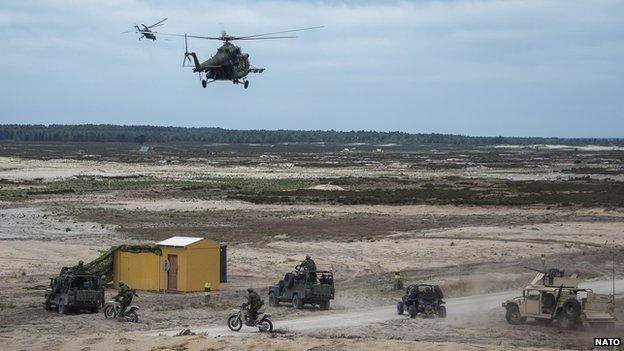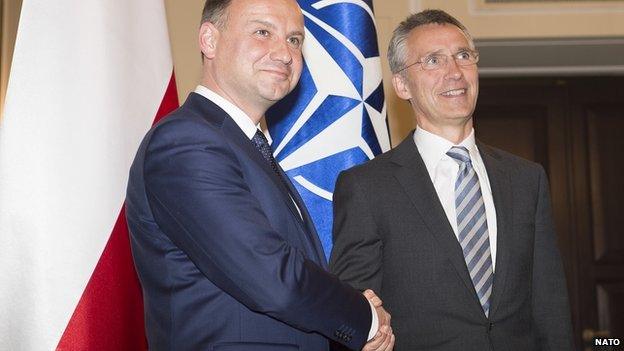Moving ever closer to a new Cold War
- Published

Nato forces have been carrying out exercises in Poland
Nato defence ministers are meeting in Brussels to agree their next steps in dealing with the renewed threat from Russia.
The US Defence Secretary, Ash Carter, arrived in Europe saying he was not looking to start a new Cold War, external.
But, in reality, both Nato and Russia are stepping up their rhetoric and strengthening their military posture.
Last week President Vladimir Putin announced he was adding another 40 long-range ballistic missiles to his nuclear arsenal.
In return, Nato accused Moscow of "sabre rattling".
The 28-member alliance is doing a bit of that too.
On a barren plain in northern Poland, Nato has been testing its new rapid-reaction, or spearhead, force for the very first time.
Its proper title is the Very High Readiness Joint Task Force, external (VHRJTF) - it is meant to be more nimble than its name.
It is a direct response to the crises in Ukraine, with the aim to have boots on the ground within 48 hours.
In the past, it would have taken the best part of a month to mobilise Nato forces to defend its own borders.
Signal to Moscow
Military units from nine Nato countries have been taking part so far - including Dutch and German forces from the west, and Norwegian and Lithuanian troops from the north.
After dozens of military convoy moves - by road, rail and air - they converged on Poland to carry out the first "live fire" exercise. Called Noble Jump, it is clearly designed to send a signal to Moscow.

General Breedlove says Nato has been provoked
Officially, the "enemy" could be anyone. In reality, there are similarities with what has happened in Ukraine.
In the exercise scenario, they are fighting a militia, not a conventional army.
It is not that dissimilar to the "little green men" who appeared in Crimea to help Russia annex it from Ukraine.
First Special Forces are sent in to capture or kill the militants, followed by helicopter gunships and tanks.
The spearhead force is meant to be just the tip of Nato's combined firepower.
Britain is promising to commit at least 1,000 troops, external to the 5,000-strong VHRJTF from next year, while the US will contribute soldiers, surveillance drones and fast jets.
Gen Philip Breedlove, the most senior Nato military commander, says: "We need to be ready because of provocation."
Like many Nato officers and officials, he seems reluctant to mention Russia.
Tough rhetoric
The alliance does not want to take the blame for fanning the flames, but at the same time it wants to talk tough.
Gen Breedlove is also keen to emphasise the difference between Nato's own exercises and those carried out by the country he does not name.

Exercise Noble Jump will send a message to the Russians
He says: "Remember our exercises are open and transparent and are sized not to be provocative.
"Put that against their snap exercises, with large forces moving unannounced that in one example turned into an invasion that changed the shape of the land." That is a clear reference to what happened in Crimea.
True, Russia has been conducting large-scale military manoeuvres involving tens of thousands of troops.
But by the end of this year, Nato will have conducted more than 300 combined military exercises, external, 100 more than last year.
It is still being pushed to do more by its newer member states, those that feel more vulnerable on Nato's eastern flank.
As we watched his special forces in action on exercise Noble Jump, a Lithuanian general told me the Baltic states could be Russia's next target.
He said: "Just on the other side of our border, we see large military units that can mobilise at short notice."
Old Warsaw Pact countries want reinforcements - especially from the US.
US plans for Europe
This week, the US defence secretary has announced plans to pre-position US military equipment in Europe.
After pulling out all of its tanks two years ago, The US is sending them back in.
A US armoured brigade - with 250 armoured vehicles, including Abrams tanks and Bradley Fighting Vehicles - will be in Europe by the end of the year.
Some will end up in Poland and the Baltic States.

Nato boss Jens Stoltenberg meets with Andrzej Duda, of Poland
Nato has already set up new military bases in those countries along with Romania and Bulgaria.
Poland's Defence Minister and Deputy Prime Minister, Tomasz Siemoniak, says: "Pre-positioning US military equipment seems like a very good idea to us because it means increasing our security."
He reminds me that, given its history: "Poland thinks very seriously about threats."
Where will this all end?

NATO membership:
1949: Belgium, Canada, Denmark, France, Iceland, Italy, Luxembourg, Netherlands, Norway, Portugal, UK, US
1952: Greece, Turkey
1955: West Germany
1982: Spain
1999: Czech Republic, Hungary, Poland
2004: Bulgaria, Estonia, Latvia, Lithuania, Romania, Slovakia, Slovenia
2009: Albania, Croatia

Already, there is talk the US might seek to strengthen its own nuclear posture in Europe to counter any threat from Russia's new missiles.
For now, that seems unlikely.
But the US has made a calculation that it needs to park the tanks near Russia's backyard, even if they are relatively few in number.
But how does this help "de-escalate" tensions?
While Nato insists this is not a new Cold War, it is starting to look and sound remarkably similar.